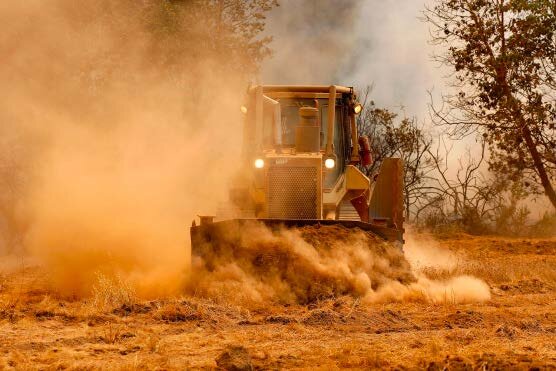
Suppression Impacts
The war on wildfire is a war on Nature.
Bulldozer firelines or "CATlines" cause extensive, lasting environmental damage and destroy Native American heritage sites.
In the era of climate change, they are rapidly becoming ineffective in stopping wildfire spread during severe weather conditions. The 2018 Carr Fire offers a case study for the kinds of damage caused by catlines whose scars still remain on the landscape.
Read FUSEE’s white paper on the Carr Fire CATlines here.
See dramatic drone imagery of the damage caused by the CATlines in this video created in collaboration with Balance Media.
Wildfire Suppression Tactics and Their Impacts
DOZERS & FIRELINES
Firelines use tools and machines to cut strips of bare mineral soil to contain fire spread.
Firelines cause soil disturbance, compaction, and erosion.
Dozerlines greatly magnify soil impacts, causing sedimentation in streams
Creates linear clearcuts that fragment closed-canopy forest habitats
Dozerlines become "ghost roads" for illegal off-road vehicle use
Dozerlines located along ridgelines where Native American artifacts and sacred sites are found can destroy these heritage sites
FIRE RETARDANT
Chemicals dumped directly or washing into waterways can kill fish and other aquatic species, and create deadly algae blooms.
It alters soil chemistry and stimulates the growth of invasive weeds that outcompete native plants.
Routinely dumped by airtankers at the wrong times, places, or conditions, chemicals do not stop or extinguish wildfires.
Airtankers with retardant is one the most expensive tools in wildfire suppression.
TREE FELLING FOR FIRELINES
Large-diameter overstory and small-diameter understory trees are removed along firelines.
Large decayed dead trees (called "snags") are some of the most valuable trees for wildlife habitat, but are routinely targeted for felling operations.
Fellerbunchers and other heavy logging equipment cut, deck, and haul away mature trees along firelines, doing commercial logging under the cover of firefighting.
BACKFIRES & BURNOUTS
"Fighting fire with fire" can significantly increase wildfire size and severity.
High-intensity, uncontrolled backfires cause high mortality of old-growth trees that often results in post-fire salvage logging.
Low-intensity burnouts eliminate vital fire refugia, can homogenize landscapes, and reduce the benefits of a natural fire mosaic of mixed-severity fires with intermixed patches of burned and unburned areas.
Suppression Costs
Suppression pending is soaring - and taxpayers are getting burned

Wildfire suppression spending is busting agency budgets by several billions of dollars nearly every year, adding to the federal fiscal crisis.
Taxpayers need greater fiscal oversight and accountability to ward off potential waste, fraud, and abuse of public funds and resources. Fire management can and must become both ecologically and economically sustainable.
FUSEE Resources
FUSEE Blog Posts
Doing What (Be)Comes Natural: Cut, Pile, Burn by Tom Ribe, Oct. 2023
Biden’s “Burn Back Better” by Tom Ribe, April 2023
Question Suppression: Getting the Whole Story about Fire Suppression Operations, Aug. 2022
Additional Resources
National Large Incident Year-to-Date Report
Large Incidents and their resulting suppression costs, updated daily
The Rising Costs of Wildfire Suppression and the Case for Ecological Fire Use
from The Ecological Importance of Mixed-Severity Fires: Nature’s Phoenix. (DellaSala and Hanson, eds.) Elsevier Academic Press. Chapter 12, by Timothy Ingalsbee and Urooj Raja (2015)
Drivers of Suppression Costs: A Literature Review and Annotated Bibliography
Northwest Fire Science Consortium, 2015
From the Ashes: Reducing the Harmful Effects and Rising Costs of Western Wildfires Taxpayers for Common Sense, 2000
Money to Burn: The Economics of Fire and Fuels Management
Western Fire Ecology Center, 2000
Fire Suppression Costs: Federal Crews Versus Contract Crews
USFS, 2005
General Accounting Office
(GAO) Reports
U.S. Forest Service (USFS) Policy Documents
Large Fires Suppression Costs: Strategies for Cost Management, Aug. 2004
National Academy of
Public Administration Reports
Wildfire Suppression: Strategies for Containing Costs, Sept. 2002
Containing Wildland Fire Costs: Improving Equipment And Services Acquisition, Sept. 2003
Containing Wildland Fire Costs: Utilizing Local Firefighting Forces, Dec. 2003
Containing Wildland Fire Costs: Enhancing Hazard Mitigation Capacity, Jan. 2004








Fire managers felt pressure to “do something” to stop the spread of the Ranch Fire, attempting a hastily planned burnout along a bulldozer fireline. But this action contradicted the advice from Forest Service risk management experts who warned that aggressive firefighting tactics had low probabilities of success given record-level fuel dryness at the time.